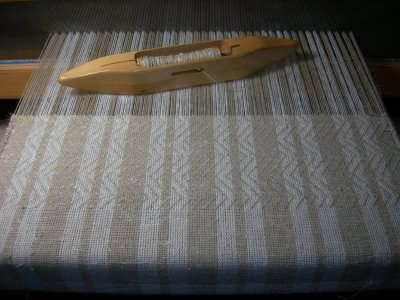 |
| Woven Shibori scarf, dyed June 8, 2013. |
In early June two more scarves on an 8 shaft Monk’s Belt threading were woven, along with a sample of each treadling. This past Saturday, the scarves and samples were indigo dyed in “watered down” indigo vats, attempting to achieve lighter shades.
The scarf above came out light/medium shade; the matching sample (below) was dipped in the vat twice to get a bit darker shade. After dyeing, the scarves and samples were rinsed as well as can be done with gathering threads still in, put in lingerie bags so any remaining water was spun out in the washer (no rinse), and hung to dry on a wood rack outside on the porch. That evening, I sat down and started clipping and removing the gathering threads, anxious to see the results.
 |
| A closer look at the border of this scarf. |
 |
| Detail of the border, tracking visible. |
After the gathering threads were removed, they were rinsed again several times until the water ran clear, and again, water was spun out so they would dry a bit faster. Normally I would start pressing them while still a bit damp, but they had dried overnight so the next morning they were misted both sides; the iron was set on cotton with highest steam setting. It takes more than one pressing to get the wrinkles out of cottolin.
While pressing the first time I noticed what appears to be tracking, something I was not expecting. I’ve had tracking happen twice, once with Harrisville wool singles, another time on a towel with cottolin warp and cotton weft (which gave a couple short diagonal lines. I’ve woven many cottolin towels, plain weave and twill, and never had tracking occur. A third steam pressing this afternoon helped a bit, but the tracking seems to be here to stay, and actually, I like the textured look it is giving to the borders. The tracking is not on the plain weave hems and plain blue areas, only the woven shibori borders.
Additional note: I just looked at the first scarf and samples. Tracking does not appear on the samples woven on the twill threading, but there is tracking on the first Monk’s Belt warp, on the dark indigo scarf and the samples, just not as visible because they were dyed darker shades of indigo.
Unfortunately, the photos, taken outdoors in good light but not direct sunlight, appear in the photos as medium and light blue, but the borders are actually medium blue on bleached (white) Swedish cottolin. Setting up a place and learning how to better photograph my work is fast moving up on my priority list.
 |
| Sample for notebook, dipped in dye bath two times. |
 |
| Back of the above sample. |
 |
| Another woven shibori scarf, also dyed June 8th. |
This scarf above was dyed in a more diluted indigo dyebath, coming out quite a light blue, and unevenly dyed, exactly the effect I was going for. I had done a little marketing research, showing the scarf in the previous post and a few samples to two women I know. They liked them all, and asked if I would have any lighter color scarves, to wear with stonewashed jeans in summer.
These two scarves were my first attempts to get the lighter, “stonewashed denim” look in woven shibori scarves. These two scarves were shown to the same women yesterday, and they wanted to know when I would bring some in for them to choose from. I think I’m on the right track!
 |
| Border area of this second scarf. |
In the border photo above, you can see how the tracking seems to add great texture to those areas of the scarf.
 |
| Detail, to show the “tracking.” |
 |
| Sample for notebook, dipped in dye bath twice. |
 |
| Back of this sample. |
Because of how the gathers happen on this Monk’s Belt threading, the bolder color and design side is really the “back” side of the fabric as it is being woven. The “back” side of the scarves and samples have lighter indigo color and more delicate design, and are actually the “right” side of the woven fabric.
All were hand-hemmed, and I chose to have the bolder, brighter indigo sides to be the right side of the fabric, but could just as easily have had the more delicate design side by the “right” side.
Now, I am thinking of other ways of finishing hems. Hand-hem, hemstitched, knotted, and others. What I am trying to keep in mind is how the particular thread looks after repeated washings, even hand washing. Cottolin, after repeated washing can get a little ratty looking on the ends of the threads, something I want to avoid. So now, I must delve into my weaving/fiber library and find options that will stand up to wear and care.
There is now a finer warp on the loom, 16/2 Swedish cotton, and I’m looking forward to seeing how the next scarves turn out!
And all this blue, I’m thinking I’d better warp up another loom with some color and different technique or structure for a little variety for all of us!























